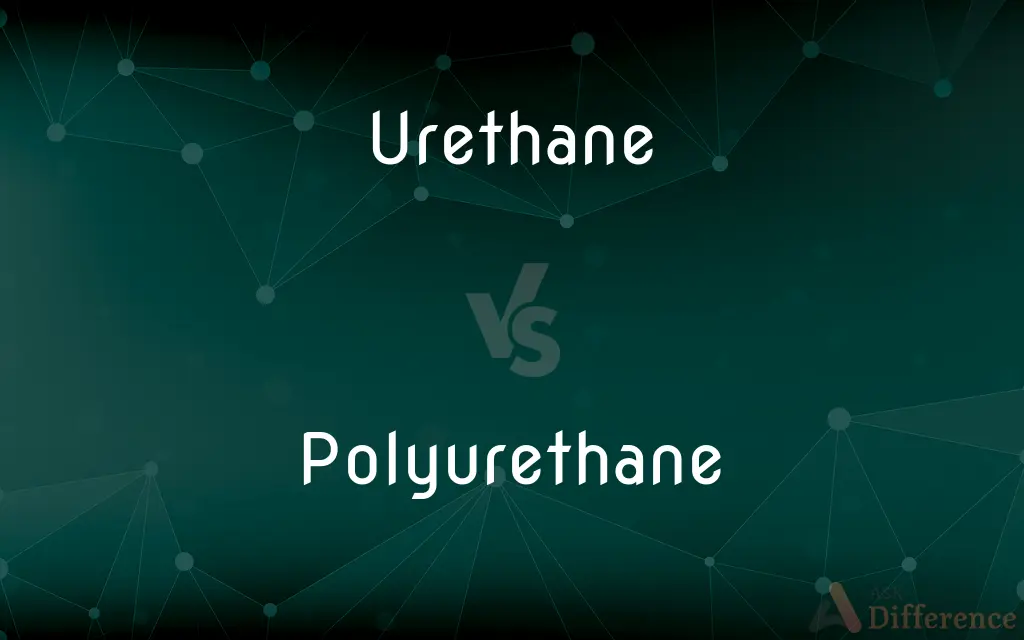Urethane vs. Polyurethane — What's the Difference?
By Fiza Rafique & Urooj Arif — Updated on April 17, 2024
Urethane is an organic compound important in many industries, while polyurethane is a polymer made from urethane links, used extensively in foams and coatings.

Difference Between Urethane and Polyurethane
Table of Contents
ADVERTISEMENT
Key Differences
Urethane, technically known as ethyl carbamate, is a single chemical compound utilized in the production of medical and recreational products. On the other hand, polyurethane is a versatile polymer formed by combining urethane units, which can be tailored into flexible foams, rigid foams, and elastomers depending on the formulation.
In applications, urethane is used primarily in specific niches such as pharmaceuticals and pesticides due to its chemical properties. Whereas polyurethane is far more prevalent in everyday items, ranging from furniture and mattresses to automotive parts and insulation materials, due to its adaptability and durability.
Urethane in its pure form serves as a building block in chemical synthesis but is not used extensively outside of specific industrial applications. In contrast, polyurethane's applications are broad, with variations that include thermosetting polymers, which harden when cured, and thermoplastics, which remain moldable.
The manufacturing process for urethane involves the reaction of ethanol with urea. Meanwhile, polyurethane is typically created by reacting a polyol (alcohol with multiple reactive hydroxyl groups) with a diisocyanate, along with suitable catalysts and additives, which can significantly alter its properties.
On an environmental note, urethane is considered stable and non-toxic, although its derivatives can vary in toxicity. Polyurethane, however, has faced scrutiny for potential health risks during its manufacture, particularly concerning isocyanate vapors, but it is generally safe once fully cured.
ADVERTISEMENT
Comparison Chart
Basic Definition
An organic compound (ethyl carbamate).
A polymer made of repeating urethane units.
Common Uses
Pesticides, pharmaceuticals.
Foams, coatings, adhesives, sealants.
Form
Simple chemical substance.
Formed into thermosetting or thermoplastic polymers.
Production Process
Reaction of ethanol with urea.
Reaction of polyols with diisocyanates.
Environmental Impact
Stable and non-toxic.
Potential risks from isocyanates during manufacture, safe once cured.
Compare with Definitions
Urethane
A colorless, crystalline compound used as a pesticide.
Urethane is effective against certain pests.
Polyurethane
Forms durable elastomers used in automotive parts.
Polyurethane is used for car bumpers and interior trims.
Urethane
Basic building block in chemical syntheses.
Urethane reactions are studied in organic chemistry labs.
Polyurethane
Applied as coatings and adhesives.
Polyurethane coatings protect wood floors from scratches.
Urethane
Known chemically as ethyl carbamate.
Urethane's chemical structure includes an ethyl group attached to carbamate.
Polyurethane
Common in everyday products due to its versatility.
Polyurethane is used in waterproof clothing.
Urethane
Found in various small-scale applications.
Urethane is sometimes used in cosmetics.
Polyurethane
Can be engineered into thermosetting or thermoplastic forms.
Thermosetting polyurethane is used in insulation panels.
Urethane
Used in medicine as a sedative and anesthetic.
Urethane was historically used in surgical procedures.
Polyurethane
Used to make flexible and rigid foams.
Polyurethane foam is common in mattresses and upholstery.
Urethane
A colorless or white crystalline compound, CO(NH2)OC2H5, used in organic synthesis and formerly as a palliative treatment for leukemia. Also called ethyl carbamate.
Polyurethane
Polyurethane (often abbreviated PUR and PU) is a polymer composed of organic units joined by carbamate (urethane) links. In contrast to other common polymers such as polyethylene and polystyrene, polyurethane is produced from a wide range of starting materials (monomers) and is therefore a class of polymers, rather than a distinct compound.
Urethane
Any of several esters, other than the ethyl ester, of carbamic acid.
Polyurethane
A synthetic resin in which the polymer units are linked by urethane groups, used chiefly as constituents of paints, varnishes, adhesives, and foams
Five coats of polyurethane
Polyurethanes serve a variety of uses
Urethane
A white crystalline organic compound, ethyl-carbamate, NH2COOC2H5, used in the synthesis of other organic compounds.
Polyurethane
Coat with polyurethane paint or varnish
The sanded and polyurethaned floorboards
Urethane
Any compound of having this general structure.
Polyurethane
Any of various thermoplastic isocyanate polymers, widely varying in flexibility, used in tough chemical-resistant coatings, adhesives, and foams.
Urethane
(informal) Polyurethane.
Polyurethane
(organic chemistry) Any of various polymeric resins containing urethane links; used in very many industrial and domestic applications.
Urethane
A white crystalline substance, NH2.CO.OC2H5, produced by the action of ammonia on ethyl carbonate or by heating urea nitrate and ethyl alcohol. It is used as a hypnotic, antipyretic, and antispasmodic. Hence, any ester of carbamic acid.
Polyurethane
Any polymer containing [-NH.CO.O-] linkages; such polymers are much used as the basis of light but rigid foams for packaging (polyurethane foam) and for hard coatings, as on floors.
Urethane
Same as polyurethane.
Polyurethane
Any of various polymers containing the urethane radical; a wide variety of synthetic forms are made and used as adhesives or plastics or paints or rubber
Urethane
An ester of carbamic acid
Common Curiosities
What is polyurethane used for?
Polyurethane is used in many applications including foams, elastomers, coatings, and adhesives.
What are the environmental impacts of polyurethane?
The manufacture of polyurethane can release harmful isocyanates, though it is safe once cured.
Is urethane toxic?
Pure urethane is stable and non-toxic, but its derivatives and misuse can be harmful.
Why is polyurethane preferred for coatings?
It forms a durable, resilient, and flexible coating that protects surfaces from mechanical wear and environmental elements.
How are urethane and polyurethane different in terms of structure?
Urethane is a single organic compound, whereas polyurethane is a polymer consisting of multiple urethane units.
Can urethane and polyurethane be used interchangeably in products?
No, they cannot. Urethane is used for specific chemical purposes, while polyurethane is used for structural, flexible, and coating applications.
What is a simple definition of polyurethane?
Polyurethane is a versatile polymer made from linking urethane units, used widely in various forms and applications.
What is urethane used for?
Urethane is used in pesticides and as a chemical intermediate in various industrial processes.
What is the main advantage of using polyurethane in products?
Polyurethane is extremely versatile and durable, making it ideal for a wide range of applications.
Are there health risks associated with polyurethane?
Yes, primarily during its manufacture due to isocyanate vapors, but it poses little risk once fully cured.
What are common products that contain polyurethane?
Common products include foams in mattresses, furniture upholstery, automotive parts, and protective coatings.
How is urethane typically produced?
It is produced by the reaction of ethanol with urea.
Is urethane commonly used in household products?
No, urethane itself is not commonly used in household products; its derivatives, like polyurethane, are more widely used.
What types of polyurethane are there?
There are thermosetting and thermoplastic polyurethanes, each with different properties and uses.
Can polyurethane be recycled?
Yes, certain types of polyurethane can be recycled, though it is complex and depends on the form of the material.
Share Your Discovery

Previous Comparison
Disobey vs. Obey
Next Comparison
Background vs. WallpaperAuthor Spotlight
Written by
Fiza RafiqueFiza Rafique is a skilled content writer at AskDifference.com, where she meticulously refines and enhances written pieces. Drawing from her vast editorial expertise, Fiza ensures clarity, accuracy, and precision in every article. Passionate about language, she continually seeks to elevate the quality of content for readers worldwide.
Co-written by
Urooj ArifUrooj is a skilled content writer at Ask Difference, known for her exceptional ability to simplify complex topics into engaging and informative content. With a passion for research and a flair for clear, concise writing, she consistently delivers articles that resonate with our diverse audience.














































